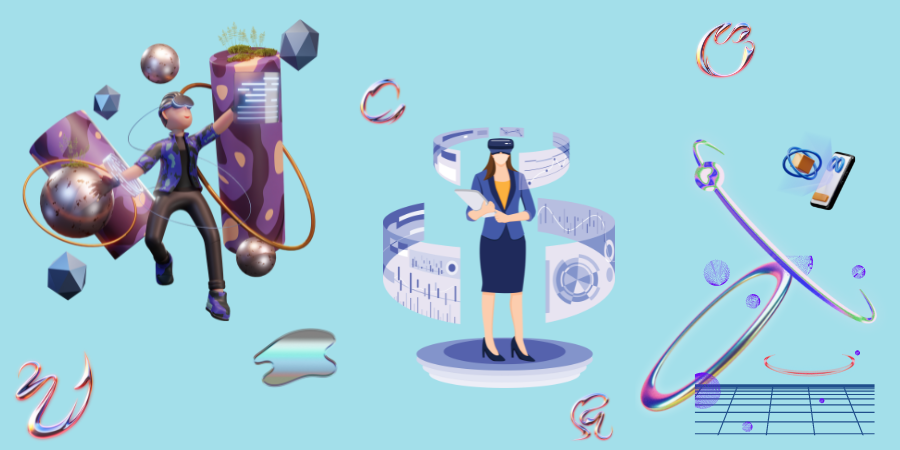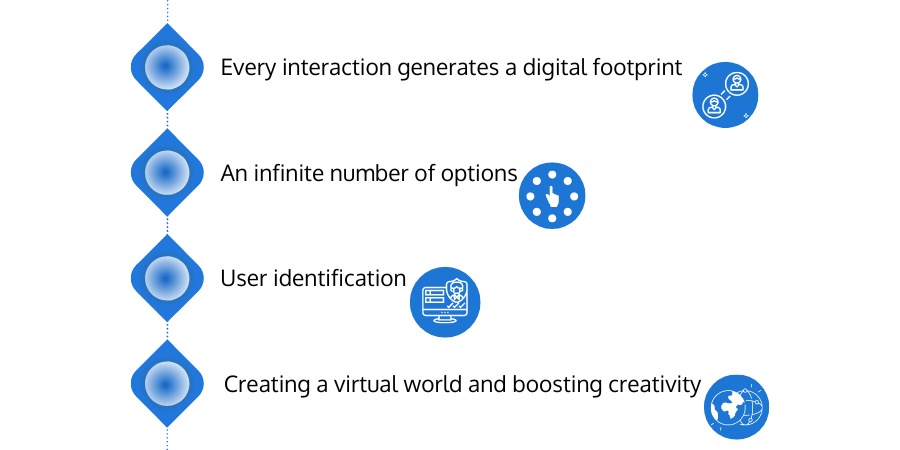
The world of technology is evolving rapidly, and virtual reality seems to be a new reality. Metaverse, Omniverse, and multiverse are the most commonly used terms in the context of artificial intelligence (AI), augmented reality, or virtual realities.
However, the road to developing a new Cyberspace (Metaverse vs. Omniverse vs. Multiverse) remains long. They are already preparing people on the ground to create cyber worlds similar to the ones used in video games.
This article will explore the significant differences between all the terms, putting them together into a cohesive and understandable world.
Introduction to Metaverse, Omniverse, and Multiverse
Metaverse
Metaverse is a distinct 3D virtual universe that exists independently of other virtual worlds or our actual world. In other words, it is a collection of autonomous virtual worlds accessed through games, websites, or applications without impacting the participant's physical life.
Many online social games and video games have reflected the concept of a metaverse. Video conferencing systems that connect coworkers amid a global pandemic are another example of the metaverse.
Multiverse
The multiverse is the technological reality in which we currently reside. In contrast to Metaverse, virtual worlds do not converge in Multiverse, and users' participation on one virtual platform has no bearing on their involvement on other platforms. Socializing in the multiverse is confined to sharing posts, images, and media via the internet.
Omniverse
NVIDIA Omniverse is a platform that connects 3D worlds to a shared virtual environment. Omniverse is utilized across sectors for collaboration and simulations of real-world infrastructure. It's similar to making a digital twin. In simple words, this platform is being used by an increasing variety of industries for projects such as design collaborations and creating digital twin simulations of real-world buildings and factories.
The term Omni means "all," and it is a merging of the Metaverse and the Multiverse. The Multiverse serves as the foundation for Metaverse, and the Omniverse serves as a protective umbrella over the digital experience provided by Metaverse and the Multiverse collectively. It will converge economics and digital identities, significantly altering how we socialize on the internet.
Key Differences Between Metaverse, Omniverse, and Multiverse
Metaverse vs. Omniverse
Facebook’s Metaverse reflects its vision of a future that will be lived in cyberspace along with life in the physical space. The enabling technologies are augmented and virtual reality, sensors, displays, artificial intelligence, and digital twins. Industries are shifting operations to cyberspace because of low transaction costs and improved efficiency. The increasing usage of digital twins in design, manufacturing, operations, and customer demonstrates a kind of metaverse.
NVIDIA's Omniverse is a metaverse populated by Industrial Digital Twins, which are autonomous (virtual) robots allowing organizations to develop anything in the virtual world with all limitations and intricacies of the physical space.
The below table shows vital differences between both universes:
| Key Metrics | Metaverse | Omniverse |
|---|---|---|
| Definition | The metaverse is analogous to the universe in terms of digital reality. | In comparison, the Omniverse is a superset or collection of all existing worlds in terms of digital existence and technology. |
| Integrated Platform | Summarize the virtual presence of digitalized community or individuality. | Omniverse refers to everything, that is, the ultimate (final) existence. |
| Standards/Criteria | The metaverse may not have its own set of norms distinct from each other. | Omniverse contains all the existing metaverses that operate according to specific parameters. |
| Current Status | The metaverse is the lowest level of the digital world, for example, Google Metaverse, Facebook Metaverse, and so on. | The Omniverse, on the other hand, is at the highest level of the digital world and contains all metaverses. |
| Interoperability | According to user demand, metaverse groups may or may not unite. | The simplicity of sharing, operationality, technology transfer, and much more are made possible by combining all of the Metaverses. |
Metaverse vs Multiverse
Definition
In the metaverse, everyone interconnects in the same digital realm where they can easily switch between activities. For example, a user can transition from gaming to shopping, working, socializing, or dating without changing platforms. These activities are associated with the same user identity.
In contrast to the metaverse, a multiverse is a collection of virtual worlds, each independent of others in terms of digital identities, assets, and laws. A person's social networking activities have no impact on their video game avatar, and vice versa, nor does their personal purchasing.
Applicability
With web 2.0, we are still in a multiverse era - interacting with many apps, websites, and games where each has its own rules regarding what and how you can do any digital activity.
Contradictory, we are witnessing the emergence of the metaverse. This includes combining social media networks, NFTs being used anonymously as profile pictures across platforms, and video games incorporating blockchain technology. It lets you own in-game assets, characters, and other virtual property.

What Are The Similarities?
Every Interaction Generates a Digital Footprint.
Technically, the three concepts involve virtual realities generated by individuals through their interactions in digital space. Every metaverse, multiverse, or omniverse interaction generates a digital trail.
An Infinite Number of Options
Another resemblance is that all three notions are open-ended and constantly evolving. As concepts, the metaverse, multiverse, and omniverse are all growing and changing. Furthermore, these three have an endless number of alternatives. The metaverse, multiverse, and omniverse provide limitless exploration and discovery opportunities.
User Identification
All three are linked to user identity. It means that what one does in one universe will be linked to what one does in another. For instance, if a person plays a game on one platform, their avatar will be the same as the one they use on another.
Similarly, if someone purchases anything on one website, their digital user identity will be tied to that purchase in some way.
Creating a Virtual World and Boosting Creativity
All universes are helping to build the virtual world and are shaping the internet's future. Metaverse, Omniverse, and multiverse are infinite spaces. In these virtual environments, you can make anything. Things that are difficult to build in this world can be built in virtual worlds.Key Takeaways
With some powerful tech corporations, such as Meta and Microsoft, attempting to develop the first global metaverse, it is evident that the concept is here for the long run. However, as of now, we inhabit a multiverse, with many platforms competing to serve us with goods and services.
For many enterprises wanting to mint their digital assets, the incentives may be high to preserve distinct online realms. Users are encouraged to protect greater anonymity by separating their identities across sites.
Given the rise of web 3.0, we can expect more fragmentation as new social media companies and other enterprises emerge. At the same time, decentralized infrastructure forms new digital worlds, whether meta-, multi-, or omniverse.














 Batoi Corporate Office
Batoi Corporate Office